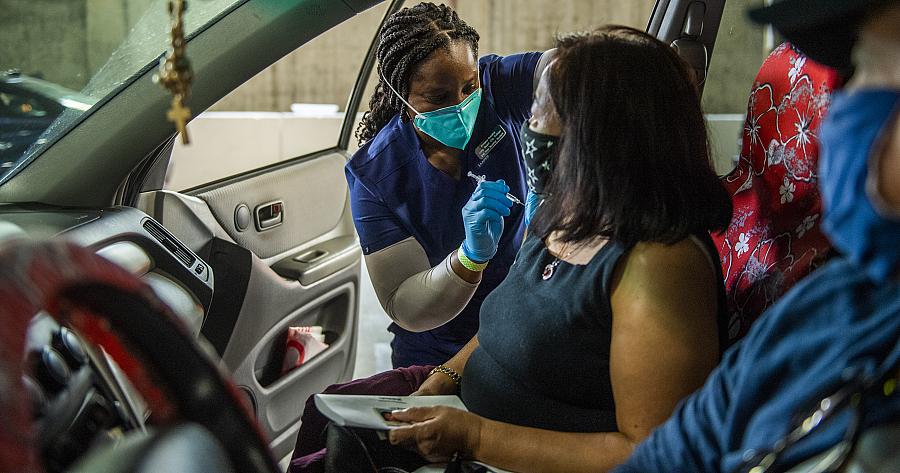COVID-19 exposes long-standing health inequities in one of California’s largest cities

Amaka Iheaka gives a shot to Yolanda Penaflor at a COVID-19 vaccination clinic at the Long Beach Convention Center on April 1, 2021.
(Photo by Thomas R. Cordova)
In many ways, Long Beach, California’s seventh largest city, is a tale of two cities, where crime, income, education and health can all change significantly depending on where you live.
In the predominantly white, upper-middle-class Eastside neighborhood in the 90815 ZIP code, the average life expectancy is 81.2 years. The neighborhood has one of the city’s lowest COVID-19 infection rates and highest COVID-19 vaccination rate, with more than 42% of its residents vaccinated.
Seven miles across town, in dense Central Long Beach, residents in the 90813 ZIP code live an average of 74.2 years — the city’s lowest life expectancy, according to a study by Long Beach Memorial Medical Center. The diverse neighborhood has one of the city’s highest COVID-19 infection rates and the lowest vaccination rate, with just 18% of its residents vaccinated.
Health disparities have existed in Long Beach for decades, but experts say those long-standing inequalities have now come into stark view as the coronavirus ravages vulnerable communities.
This disparity has been especially notable in the city’s COVID-19 vaccine rollout. Long Beach is one of just four cities in the state with its own health department and has more control over how it distributes the vaccine.
And unfortunately, like in many jurisdictions, the vaccine has been largely going to residents in wealthier areas compared to denser, low-income neighborhoods with higher COVID-19 rates.
City numbers also show stark disparities by race. White people make up 28% of the city’s population but account for 34% of all vaccinations, while Hispanic people account for 42% of the population and just 21% of vaccinations. Black residents account for 12% of the population and 7% of vaccinations.
The disparities highlight the complicated layers of race, poverty and access that all contribute to lower vaccination rates and higher infection rates in the city’s most vulnerable communities.
The Long Beach Post’s project for the 2021 California Fellowship will feature an in-depth series of stories looking at several communities that have been hard-hit by the pandemic and the many different, historical reasons for these disparities.
The first community we will profile is the city’s Cambodian community, which is one of the largest in the world outside of Cambodia. Cambodians in Long Beach face unique challenges, with many of the older residents experiencing PTSD from the Cambodian genocide and language barriers. While other health clinics in the city have been able to get vaccine doses, community activists have had to push for more help to get the vaccine to neighborhood clinics. Recently, the city held a pop-up vaccine clinic for more than 300 Cambodian residents, but local community organizers had to scramble to get hundreds of people signed up when the city’s sign-up system failed.
We also will focus on Long Beach’s large Black community and the unique problems it faces in getting people vaccinated, including a long history of mistrust of the medical system.
And finally, we will profile the Latino, Pacific Islander and Filipino communities on the Westside, where COVID-19 rates and deaths are the highest in the city. This area has historically high pollution rates due to its proximity to the Ports of Long Beach and Los Angeles and major freeways, and has among the highest asthma rates in the city. We plan to examine possible connections between pollution, the area’s asthma rates and the high COVID-19 rates.
Health officials have been especially alarmed by the high number of deaths in the city’s Pacific Islander population, which could be one reason for the Westside’s high death rate compared to other areas of the city.
City numbers show that Pacific Islanders are dying from COVID-19 at a higher rate than any other race. They are nine times more likely to be hospitalized and seven times more likely to die compared to white residents.
Our project will include a multimedia component with videos as well as live-streamed chats on our Facebook and Twitter page with community activists focusing on solutions.
